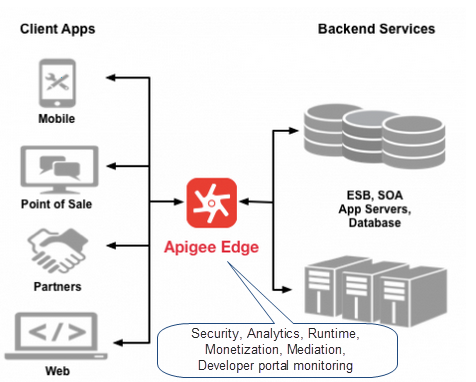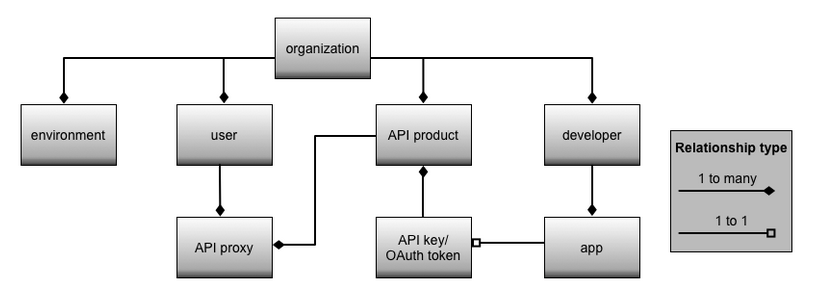What is Apigee Edge Server?
Apigee Edge is a platform for developing and managing APIs. By fronting services with a proxy layer, Edge provides an abstraction or facade for backend service APIs and provides security, rate limiting, quotas, analytics, and more.
Apigee Edge enables you to provide secure access to the services with a well-defined API that is consistent across all of the services, regardless of service implementation. A consistent API:
- Makes it easy for app developers to consume the services.
- Enables you to change the backend service implementation without affecting the public API.
- Enables you to take advantage of the analytics, monetization, developer portal, and other features built into Edge.
The following image shows an architecture with Apigee Edge handling the requests from client apps to the backend services:

Figure 1 : Architecture showing request handling of Apigee Edge server
The following image shows the major components of the Edge organizational model. This model defines how the APIs, API products, apps, and app developers are all related within Edge.

Figure 2 : Apigee Edge organizational model
organization - An organization is the top-level container in Apigee Edge. It contains all your API proxies and related resources.
environment - Network-accessible runtime deployment containers (typically named 'test' and 'prod') available for APIs on Apigee Edge. An API proxy must be deployed to an environment before the API it exposes is accessible over the network. By default, organizations are provisioned with two environments: 'test' and 'prod'.
user - users registered with the organization. You must specify the user's role in the organization.
API - An 'application programming interface' - an interface that makes it easy for an application to 'consume' capabilities or data from another application.
API proxy - A facade on Edge for one or more APIs, generic HTTP services, or applications (such as Node.js).
API product - A collection of API resources (URIs) combined with a quota, or 'service plan', which is published to app developers at design time. API products can in turn be bundled into API packages for monetization.
app - An abbreviation of 'application'. It refers to the mobile applications that consume APIs.
developer - Developers who have registered with the Edge organization.
API key/OAuth token - An API key (known in Apigee Edge as a consumer key) is a string value passed by a client app to the API proxies
When the clients send requests to access applications/services hosted behind the Apigee Edge, the Apigee Edge passes the requests to the corresponding component in the Edge organization. The component then communicates the requests to the backend targets such as database, app servers, etc. to which it has been associated with. The backend targets process the requests and delivers response to the component. Finally, the Apigee Edge delivers the response to the clients.
Why Monitor Apigee Edge?
The Apigee Edge is a simple-to-use yet robust API management platform that offers features such as analytics and operations automation, and API developer management. The platform can safeguard backends, APIs, and messages with tools like access control, API key v erification, OAuth, and XML/JSON threat protection. Apigee Edge can be deployed both on-premises and in the cloud. In digital business infrastructure where the Apigee Edge is installed as a frontline system, the Apigee Edge plays a pivotal role since all user requests to the other tiers are routed via the Apigee Edge and hence, any slowdown or problem in the Apigee Edge tier can adversely impact the end user experience. To avoid this, administrators should continuously monitor the request processing capability and responsiveness of each component in the Apigee Edge and latency issues in the Apigee Edge. To cater to this requirement, eG Enterprise offers a dedicated monitoring model using which administrators can monitor each of the components in an organization of the Apigee Edge in a seamless manner.
